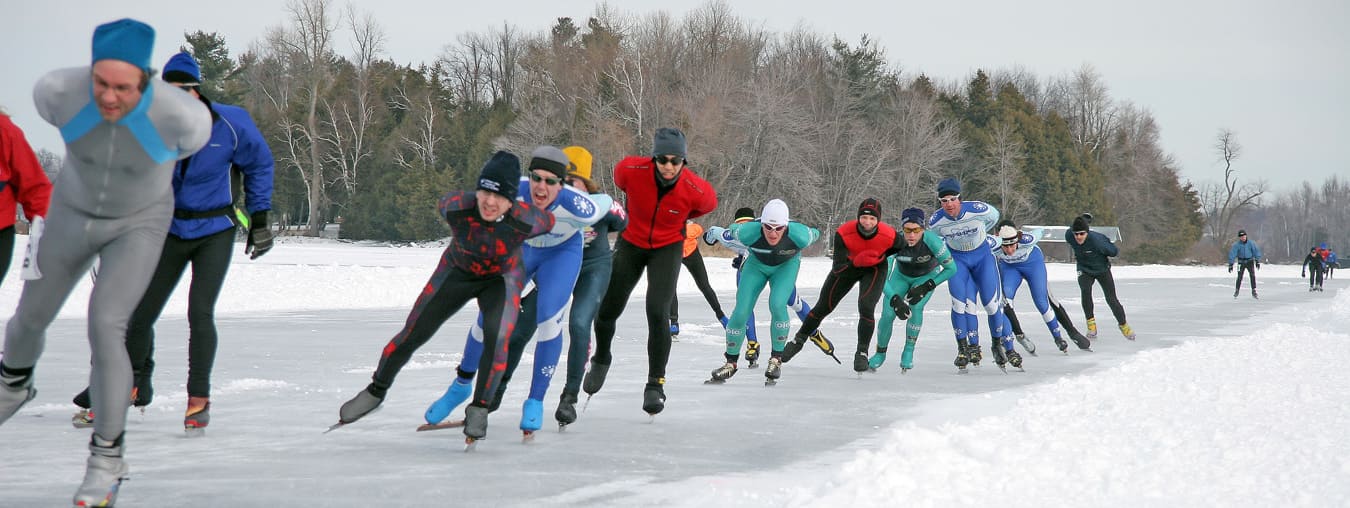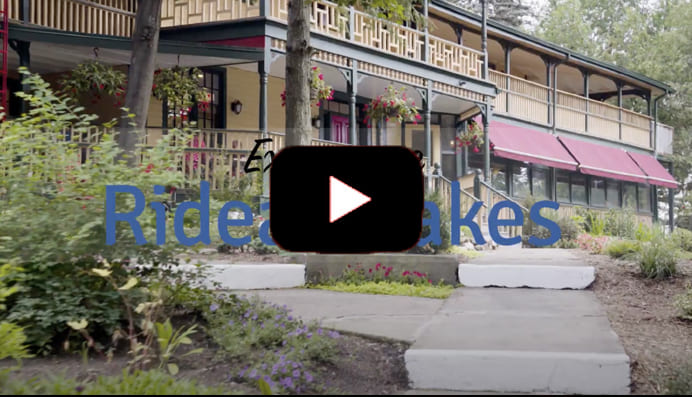Within a radius of several miles exist ten substantial stone homes/barns, mostly built between 1851-1861, testament to the economic wellbeing of these mid 19th century farmers. Included in the 1841 census are names which continue to resonate in the locality: Bolton, Eaton (the Freeland PS property was deeded by the Eaton family), Freeland, Graham, Green, Hull, Myers, Poole, and Sheldon. In addition, there are a number of fine late 19th c homes. Spring time along Freeland Road, William Freeland’s stone barn in the background
Spring time along Freeland Road, William Freeland’s stone barn in the background
All original Freeland settlers would have followed the same basic land clearing/ farming practices as Ferris Bolton’s family. In 1831 his father, John Bolton, had emigrated from County Wexford, Ireland with his family, settling on a bush farm, north of Portland village. John later purchased from the government one hundred acres of solid bush on the shores of Big RIdeau Lake. ‘He had to cut down trees to get space for a twelve foot square shanty…. he bought a yoke of oxen and started to clear the timber off his land..(these) he drew to the lake (and sold)… (John married)… in 1846, living two years in this shanty… when they built a fairly large log house with an upstairs (1848)… these were busy interesting years. The hay and grain crops were all cut and handled by hand. Potatoes and corn were harvested by hand, fall ploughing had to be done, underbrush and old timber taken out of the bush…Five acres (clearing) was the usual winter’s work…In 1859 the first part of our stone house was built and we moved from the log house by the lake 80 rods nearer the school. We now had only two and a half miles to walk (to school)…When the ice was good we would skate on the lake to within half a mile of the school….’
 Ferris Bolton beside Freeland Public School'(In the) summer of 1857, I was 4 years old and attended school in the log school house for four days. My cousin, Jane Ann Henderson, was the teacher. She received $112.00 (annual) as a salary and board. She took two weeks at each home where there were children attending school and had two weeks holiday in July. We had three miles miles each way to walk to school. That summer (1857) a stone school house was built and our trip was shortened a half mile each way…..In the spring when I was eight years my father asked me to stay home from school and started me to work .…This ended my education in the summer and I went to school in the winter after this and gave that up when I was 13 years old with the exception of the winter I was 17…’
Ferris Bolton beside Freeland Public School'(In the) summer of 1857, I was 4 years old and attended school in the log school house for four days. My cousin, Jane Ann Henderson, was the teacher. She received $112.00 (annual) as a salary and board. She took two weeks at each home where there were children attending school and had two weeks holiday in July. We had three miles miles each way to walk to school. That summer (1857) a stone school house was built and our trip was shortened a half mile each way…..In the spring when I was eight years my father asked me to stay home from school and started me to work .…This ended my education in the summer and I went to school in the winter after this and gave that up when I was 13 years old with the exception of the winter I was 17…’
In 1947 this school closed, having also served also as a centre for social events of the Freeland community.
 Samuel Poole home, Built mid 1850sThe 1851 census showed the Samuel Poole family, a neighbour of John Bolton, living in a log cabin (family legend tells the story of Poole family members coming downstairs on winter mornings to snow covered steps, blown in between the chinks in the logs). Incidentally Samuel Poole’s son, William, married Olive Bolton, younger sister of Ferris Bolton. By 1861 this log home had been replaced with a fine sandstone story and half ‘Ontario cottage’, similar in style to the other Freeland area sandstone homes, this one built from stone quarried on the Poole property.
Samuel Poole home, Built mid 1850sThe 1851 census showed the Samuel Poole family, a neighbour of John Bolton, living in a log cabin (family legend tells the story of Poole family members coming downstairs on winter mornings to snow covered steps, blown in between the chinks in the logs). Incidentally Samuel Poole’s son, William, married Olive Bolton, younger sister of Ferris Bolton. By 1861 this log home had been replaced with a fine sandstone story and half ‘Ontario cottage’, similar in style to the other Freeland area sandstone homes, this one built from stone quarried on the Poole property.
‘Through the first half of the 1800s, the growing of cereal grains such as Red Fife wheat (for flour) and barley (for malting and distilling) were primary economic crops of north Leeds. However after several decades go mono- cropping the … soils were being depleted. …. local agriculture by the 1860s was shifting to mixed farming with pasture.. nurturing herds of milk cows. The herds supplied the milk for many local cheddar cheese factories that marked a new era of socio-economics’: Doug Bond Editor ‘Memoirs of The Bolton Family’
 1950s aerial photo of the Samuel Poole farm with its various outbuildings (including a ‘bank’ barn) amid a mixed farming scenarioThe Poole family became part of this change with the construction of a cheese factory alongside the creek flowing through their property; the factory provided services to the surrounding farmers who arrived each morning with cans of fresh milk. Mixed farming continued until after WW 2, when, increasingly, farms were abandoned and vacationing cottagers purchased lots along the shores of those farms bordering on Big Rideau Lake.
1950s aerial photo of the Samuel Poole farm with its various outbuildings (including a ‘bank’ barn) amid a mixed farming scenarioThe Poole family became part of this change with the construction of a cheese factory alongside the creek flowing through their property; the factory provided services to the surrounding farmers who arrived each morning with cans of fresh milk. Mixed farming continued until after WW 2, when, increasingly, farms were abandoned and vacationing cottagers purchased lots along the shores of those farms bordering on Big Rideau Lake.
The Rideau Lakes MHAC is indebted to Ferris Bolton for his ‘Memoirs of the Bolton Family’, 1932
By Diane Haskins
Municipal Heritage Advisory Committee, Township of Rideau Lakes






















